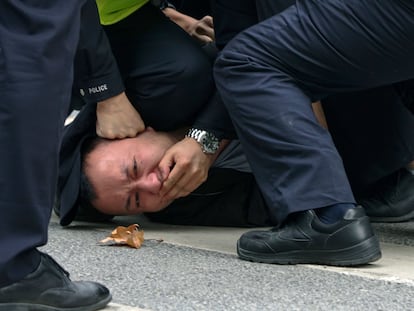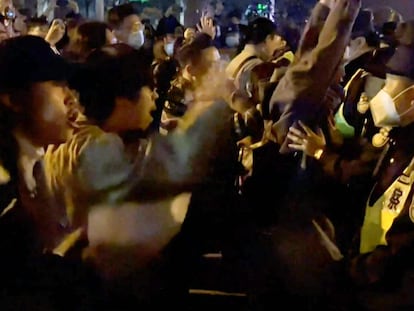China backtracks on zero-Covid policy in wake of mass protests
Beijing has approved easing measures after citizens took to the streets in a rare show of public anger over draconian restrictions to combat the spread of the coronavirus


China is gradually removing the bricks of the country’s immovable anti-pandemic wall, erected almost three years ago to combat the coronavirus. Just 11 days after mass protests shook the streets of more than 20 cities across China, Beijing has provided unmistakable signs that its iron-clad zero-Covid policy is in its final throes.
The Chinese State Council has approved a 10-point list for easing measures that will, among other issues, permit people who have been infected with Covid-19 to isolate at home instead of at mandatory quarantine centers as had been the case until now, provided that the case is mild. Furthermore, citizens will be allowed to purchase antigen tests and drugs to treat the symptoms of the disease, such as antipyretics, without restrictions. As such, Beijing has taken the first definitive steps towards living with the virus, as the vast majority of countries around the world have already done.
In addition to the list of Covid relaxation measures, the Politburo’s Central Committee avoided explicit mention of the zero-Covid policy in the official account of its most recent meeting, held on Tuesday and headed by Chinese President Xi Jinping, in another sign that Beijing is backtracking on the unpopular legislation in the wake of a rare public show of disapproval towards the Communist Party hierarchy. In the text of the committee meeting, published by official state news agency Xinhua, there is talk only of “better coordinating” and “optimizing” the control and prevention of the pandemic. The omission, which was clearly deliberate, can be interpreted as the party having decided to shelve the zero-Covid mandate and look to the future. The Politburo had already stated that 2023 would be a year focused on economic “stability and progress,” with China’s growth rate forecast to lag behind much of the Asia-Pacific region in the short-term.
The new measures adopted will be applied across the entire country and follow steps already taken in cities including Beijing and Shanghai, where the protests were most keenly felt and the government response more swiftly delivered. Among the key decisions is to do away with mass daily PCR testing, one of the cornerstones of the zero-Covid policy, with the use of antigen tests to be encouraged instead. Negative PCR tests will no longer be required to gain entry to the majority of public facilities – excluding schools, kindergartens and medical centers – and the ubiquitous and sophisticated QR code system governing access to commercial establishments, residential complexes and public transportation looks set to be phased out.
Mass vaccination mobilization
The Chinese authorities have also called for the cooperation of “the whole of society to participate in the mobilization of the vaccination of the elderly,” according to the text released by Xinhua on Wednesday. This has proven a weak point for China in terms of a future large-scale reopening with only around 40% of people over 80 in China having received a booster jab. Schools have been asked to carry out their educational activities on-site as long as they are not affected by a Covid outbreak, and when one is detected to inform authorities of the “precise ones of risk,” in a move that appears to be a precursor to a plan to prevent systematic and generalized school closures.
The turnaround has come as a surprise to many Chinese after living for so long under constant warning of the dangers of the virus. The shift in strategy has been accompanied by new information disseminated through state media underlining the low mortality rate of the Omicron variant. “Everything has changed in 24 hours,” says a resident of Beijing, who is in self-isolation after a positive antigen test. “All of a sudden, Omicron has gone from being a wolf to becoming a little sheep, with a lot of experts saying it is nothing.”
China is currently experiencing a surge in infections, with official figures putting the number of recorded cases in Beijing at 4,000, although with sales of home antigen tests through the roof, that number is probably considerably higher.
“Zero covid is officially dead, it’s over in China,” Xinran Andy Chen, a Shanghai-based analyst at the Trivium China policy research center, tells EL PAÍS by phone while acknowledging that everything is moving “faster than expected,” as a result of the protests, although there are other factors in play such as the enormous cost of maintaining centralized quarantine centers and Xi’s recent foreign trips – before September, the premier had not left the country since the beginning of the pandemic.
What remains unclear, and is one of the biggest question marks surrounding Beijing’s softened stance, is what will happen when a new wave of the pandemic hits a country that has been almost entirely sealed off from the rest of the world until now. An estimate by Wigram Capital Advisors, cited by the Financial Times, highlights a potentially unprecedented winter surge that could result in around 20,000 deaths per day by March 2023, following the Chinese New Year vacation. So far, China has recorded just over 5,000 Covid-related deaths, according to official figures.
Sign up for our weekly newsletter to get more English-language news coverage from EL PAÍS USA Edition
Tu suscripción se está usando en otro dispositivo
¿Quieres añadir otro usuario a tu suscripción?
Si continúas leyendo en este dispositivo, no se podrá leer en el otro.
FlechaTu suscripción se está usando en otro dispositivo y solo puedes acceder a EL PAÍS desde un dispositivo a la vez.
Si quieres compartir tu cuenta, cambia tu suscripción a la modalidad Premium, así podrás añadir otro usuario. Cada uno accederá con su propia cuenta de email, lo que os permitirá personalizar vuestra experiencia en EL PAÍS.
¿Tienes una suscripción de empresa? Accede aquí para contratar más cuentas.
En el caso de no saber quién está usando tu cuenta, te recomendamos cambiar tu contraseña aquí.
Si decides continuar compartiendo tu cuenta, este mensaje se mostrará en tu dispositivo y en el de la otra persona que está usando tu cuenta de forma indefinida, afectando a tu experiencia de lectura. Puedes consultar aquí los términos y condiciones de la suscripción digital.










































